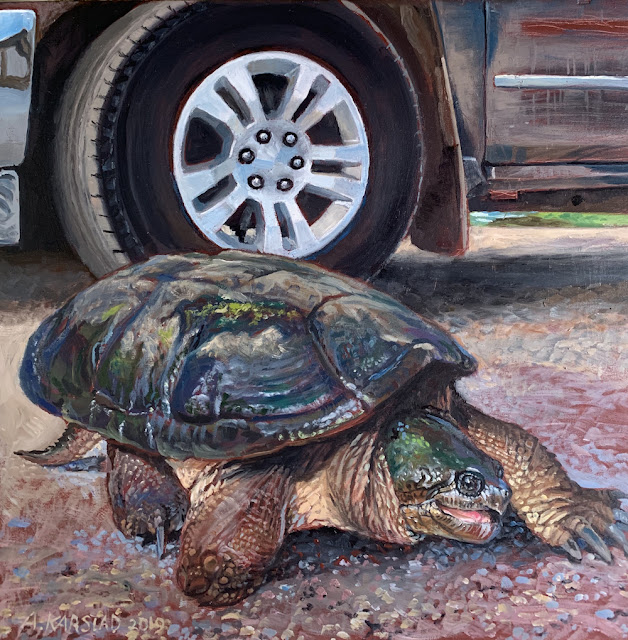Making it Across
 |
| "Making it Across, Spednic Snapping Turtle" (oil on canvas 10 x 10 in.) |
It's a hard life, being a turtle! I painted this portrait of a Snapping Turtle, from a photo taken by Don McAlpine of the New Brunswick Museum, in June last year at the BiotaNB survey of Spednic Protected Natural Area, near McAdam, NB. It was crossing the road at the bridge over Diggity Stream.
I've shown a thin strip of riverbank beneath the truck, and a reflection of part of the bridge in the chrome bumper, but most of the painting is devoted to the task at hand - Making it Across. The truck, in the original photo, was parked on the far side of the road, but in planning the painting, I took a reference photo of a truck wheel from a more ominous perspective - that of a crossing turtle. I wanted it to look as if the driver has rolled up close to watch it cross and to hurry it along. Or maybe the truck is threatening the plodding reptile - defending the road as Truck Territory.
Snappers raise their bodies up on surprisingly long legs as they walk, giving a sort of Dinosaur impression as they cross roads - which you can see from a distance, before the turtle crouches at your approach. You've really got to be driving distractedly, to not notice an adult Snapping Turtle, but sometimes they're hit deliberately - by truck, or gun, or even with whatever weapon is at hand, as there's still a persistent folk-myth about Snappers feasting on ducklings.
As Wolves with Deer, swampy lurkers prey on the outliers and the weakest - but the parents of Ducklings are quite capable of keeping enough of their little ones safe, and raise a nestful of progeny each year during their several-year lifespan. The nests of turtles, on the other hand, are persistently wiped out most years, especially when they use traditional nesting sites well-known to Racoons, Skunks, and Coyotes. These efficient predator/scavengers leave not one egg behind when they dig up a nest. When you see a large Snapping Turtle patiently dropping eggs into a hole that she's dug in a gravelly road shoulder, remember that this is an individual who may be older than your grandmother. The largest mamas may be centenarians! Through the many decades of her life, how many nests have escaped predation, and of those, how many hatchlings have survived to dig their own nests?
Everything that isn't vegetarian will eat baby Snapping Turtles whenever they find them - Herons, Water Snakes, Mink, Otter, some fish, and especially Bull Frogs. Even adult Snappers are vulnerable to natural predators while hibernating. Coyotes and Otters eat whatever parts they can reach of a cold and helpless turtle who perhaps did not bury itself well enough for the winter, or was exposed when water levels dropped. That's what happened to the Snapper I've painted - it's front foot and at least one hind toe on the right are missing. The longest-studied population of Snapping Turtles in Canada, at the Algonquin Wildlife Research Centre, suffered 50% mortality by River Otter predation in the winters of 1986–1989, when Otters were eating the eggs out of hibernating females. In the quarter century since those fateful years, the population has failed to recover, despite careful observation and protection of many nests from predators. (information from Keevil, M. G., R. J. Brooks, and J. D. Litzgus. 2018. Post-catastrophe patterns of abundance and survival reveal no evidence of population recovery in a long-lived animal. Ecosphere 9(9):21 pp.)
Baby Snappers emerge in the fall from gravel road shoulders near creeks and wetlands. Since they are so small, it's hard to count those that get squashed by vehicles unless you're walking and looking for them - so the percentage of hatchlings that are killed on roads would be hard to know.
Snapping Turtles are listed as a Species At Risk, despite their wide occurrence, just because it isn't known how their populations work, and what their potential is for surviving as a species in the face of road mortality.

This little one was picked up by Fred from the road at the Fly Creek bridge, near New Dublin, Ontario, shortly after it emerged on 2 September. After taking its picture, we released it in the creek.
Congratulations on having made it across again this year, big mama Snapper - here's wishing you many successful nests and lucky nestlings!
My painting "Making it Across, Spednic Snapping Turtle" is in the permanent collection of the New Brunswick Museum.




...and here's an optimistic Turtle quatrain for the painting (all my Turtle O2Bs seem to be optimistic) -
ReplyDeleteOh to be stub-foot Chelydra,
Survivor of tire crush,
Starting on another century
No longer hatchet-doomed for ducks.
Aleta's text hints at the things that were said when we were kids, when part of "conservation" was killing Snappers with hatchets because they were said to eat ducklings, but she grumped that the stub was more likely due to a gnawing predator than having the foot run over by a vehicle.
Here's another optimistic O2B from 2007 -
Oh to be the garden Turtle,
and to spurn Petunias' rights,
just to make the soil fertile
With September's snapping sprites.
If North America is Turtle Island, and the Celydridae are the most distinctive element of its chelonian fauna, maybe this is are our primary totem species, and their conservation a central element of showing that we know how to live here.